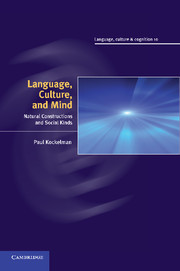Book contents
- Frontmatter
- Contents
- List of illustrations
- Acknowledgements
- 1 Language, culture, mind: emblems of the status human
- 2 Inalienable possessions: what hearts, mothers, and shadows have in common
- 3 Interclausal relations: how to enclose a mind by disclosing a sign
- 4 Myths about time and theories of mind: why the moon married the sun
- 5 Other minds and possible worlds: when psychological depth is dialogical breadth
- 6 Interjections: why the centre of emotion is at the edge of language
- 7 Conclusion: natural constructions and social kinds
- Appendix A Transcription conventions
- Appendix B The Marriage between the Sun and the Moon
- References
- Index
6 - Interjections: why the centre of emotion is at the edge of language
Published online by Cambridge University Press: 04 May 2010
- Frontmatter
- Contents
- List of illustrations
- Acknowledgements
- 1 Language, culture, mind: emblems of the status human
- 2 Inalienable possessions: what hearts, mothers, and shadows have in common
- 3 Interclausal relations: how to enclose a mind by disclosing a sign
- 4 Myths about time and theories of mind: why the moon married the sun
- 5 Other minds and possible worlds: when psychological depth is dialogical breadth
- 6 Interjections: why the centre of emotion is at the edge of language
- 7 Conclusion: natural constructions and social kinds
- Appendix A Transcription conventions
- Appendix B The Marriage between the Sun and the Moon
- References
- Index
Summary
Introduction
Suppose that human beings are those entities whose agency is both enabled and constrained by the fact that their practices and their representations of their practices are never commensurate. Were this the case, the relevant locale for cross-culturally comparing what is distinctly human would not be a set of grammatical categories, a lexical field, a class of mental states, a range of ritual practices, or an ensemble of social relations. Nor would it be a philosophy, a linguistic ideology, an ethnopsychology, a system of religious beliefs, or a Weltanschauung. Rather, it would be a relationship between two sets of practices, where one set relates to the other set as sign to object, or interpretant to sign. That is, what is shared between any two human populations may be sought by inter-culturally comparing the intra-cultural relationships between two sets of practices, in which one set functions as a representation of the other.
In this chapter, I use ethnographic and linguistic data to relate two sets of practices among speakers of Q'eqchi'-Maya: first, the usage of interjections (such as the particles oof, ouch, and yikes); and second, the representation of the meaning of those interjections through the meta-linguistic usage of complement-taking predicates (such as the verbs desire, fear, see, say, and know). This relationship is compared to interpretations of interjections offered by western philosophers and linguists.
- Type
- Chapter
- Information
- Language, Culture, and MindNatural Constructions and Social Kinds, pp. 163 - 201Publisher: Cambridge University PressPrint publication year: 2010



